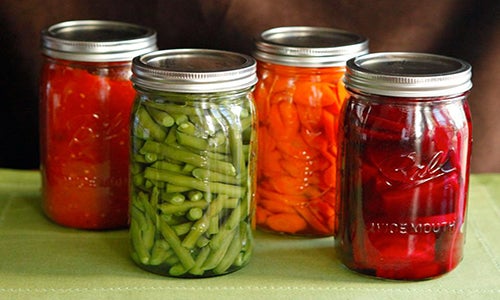Beaufort County Extension offering home food preservation classes
Published 10:57 am Tuesday, April 26, 2022
|
Getting your Trinity Audio player ready...
|

When it starts getting warm and the gardens are being planted you may start thinking about learning how to can your own foods. The price of everything is rising in the grocery store, so now might be a good time to invest in some Hot Water Bath canning equipment and save some money by preserving foods. There will be an initial investment but once you have your supplies it will be worth the investment for years to come. Here are several things you will need to get started.
Canning supplies for jams and jellies and pickles and other high acid foods include: hot water bath canner for high acid foods only, jars with two piece lids and rings (made for canning), wide mouth jar funnel, an instant read thermometer, jar lifter, lid lifter and canning salt, it is free of iodine which cloud the liquid.
A water bath canner is a tall stockpot with a lid and a rack. If you do not have a rack, use a cake cooling rack or extra ring bands tied together to create a rack. A Granite Ware 21.5-Quart Water Bath Canner with Jar Rack will range in cost of about $25-$75.
Buy mason style canning jars, new lids, and ring bands, $10-$15 depending on the size you will need. After your first season, you can reuse your jars and rings but you will need to buy new canning lids every year, they run about $4 for a 12 pack.
The rest of the supplies are available as a canning kit (jar lifter, bubble freer, wide-mouth funnel, lid lifter) and runs about $10-$15. You also will need various bowls, and pans depending upon your project, paper towels, dishcloths, and a timer.
And don’t forget a permanent marker to label lids with contents and date. Most of these supplies can be found at any hardware store and local grocery stores carry some canning supplies.
Select a research-based recipe and read through it completely and follow every step with measured ingredients and check the jar size and the processing time for quality and food safety. Only high-acid foods (Jams, Jellies, Pickles) can be safely processed in a boiling water bath.
All low acid foods (vegetables like green beans) must be pressure canned. This allows the temperature to rise above 212 degrees F. of boiling temperature to 240 degrees F. inside the canner and destroys C. Botulinum. If you are canning low acid foods or meats you must use a pressure canner. Sources of research-based recipes include the Penn State Let’s Preserve Series, USDA Complete Guide to Home Canning, the National Center for Home Food Preservation, or So-Easy to Preserve.
Check the List of Ingredients. Do not forget the canning salt, sugar, and other ingredients listed in the recipe. Purchasing these items early will have you prepared for the day of harvest.
Prepare Jars and Lids by checking the jars for any nicks, cracks, or uneven rims. Check lids to avoid scratches and uneven or missing sealing compounds. Check that ring bands fit jars.
Wash jars, lids, and ring bands in hot soapy water; rinse, drain.
Sterilize jars if they will be processed for less than 10 minutes by covering jars in boiling water for 10 minutes. Jars processed 10 minutes or more do not need to be sterilized. Place jars that will be filled with hot product in 180°F water to heat jars before filling. This may be in water heating in the canner or a separate pan. Another option for heating jars is to wash them in the dishwasher and time to remove the jars from the dishwasher when you are ready to use them.
Heating jar lids are optional.
Prepare Boiling Water Canner by placing a rack in the bottom of the canner so jars will not be on the bottom of the pot. Fill the canner at least ½ full of water. Cover and heat to 140°F for food that is packed into jars raw; heat to 180°F for foods packed into jars hot. Heat an additional pan of water to have in reserve for filling the canner later.
Prepare Food to be canned. This step depends upon the food being canned and the recipe instructions.
Prepare only one canner load at a time, do not double the recipe. Sort items by size and quality, and remove any spoiled products. Store canned goods in a dark, cool area of your home.
Five additional things to remember:
1. Discard old recipes published before 1994. Old recipes may have inadequate processing times, inaccurate processing methods, or lack adequate acidity.
2. Center the canner over the burner. Select an appropriate size burner. Canner should not extend more than 2 inches beyond the burner.
3. Clean your canner after each use.
4. Electric Pressure Cookers for example Instant Pots are not approved for canning.
5. Don’t use recipes from social media sites like Google, TikTok, Pinterest, and Facebook unless they are from a .edu source. Following a tested recipe means you know your food is safe to eat.
If you would like to learn more the Beaufort County Cooperative Extension will be offering the following food preservation Instructional Classes free of charge.
-Boiling Water Bath Class, Pickles (jams and jellies): Thursday, May 19, 10 a.m. to noon or 6-8 p.m.
-Pressure Canning: May 26, 9:30 a.m. to noon or 5:30-8 p.m.
-Dehydrating: Thursday, June 2, 10 a.m. to noon or 6-8 p.m.
-Freezing: Thursday, June 9, 10 a.m. to noon or 6-8 p.m.
Registration is open now. Please contact the Beaufort County Extension Center, 155 Airport Road, Washington, NC 27889 or call 252-946-0111 or email Louise_Hinslelly@ncsu.edu and reserve your spot at least two days before any class is offered so that information will be printed for you.






